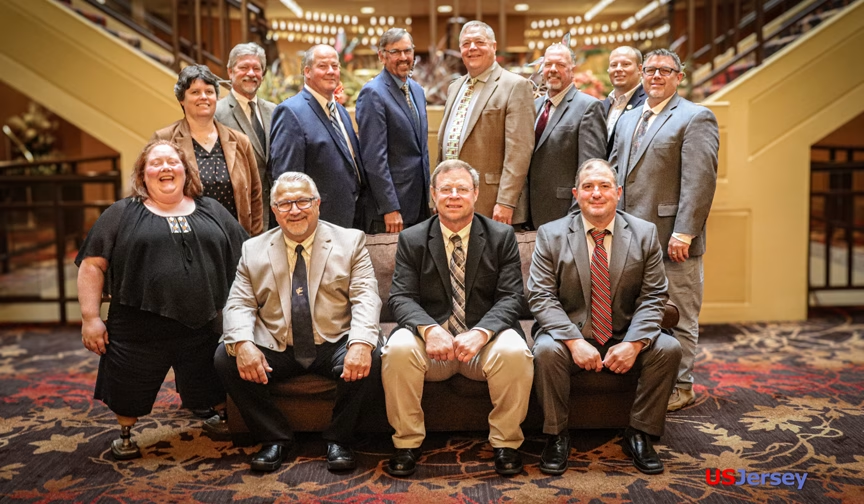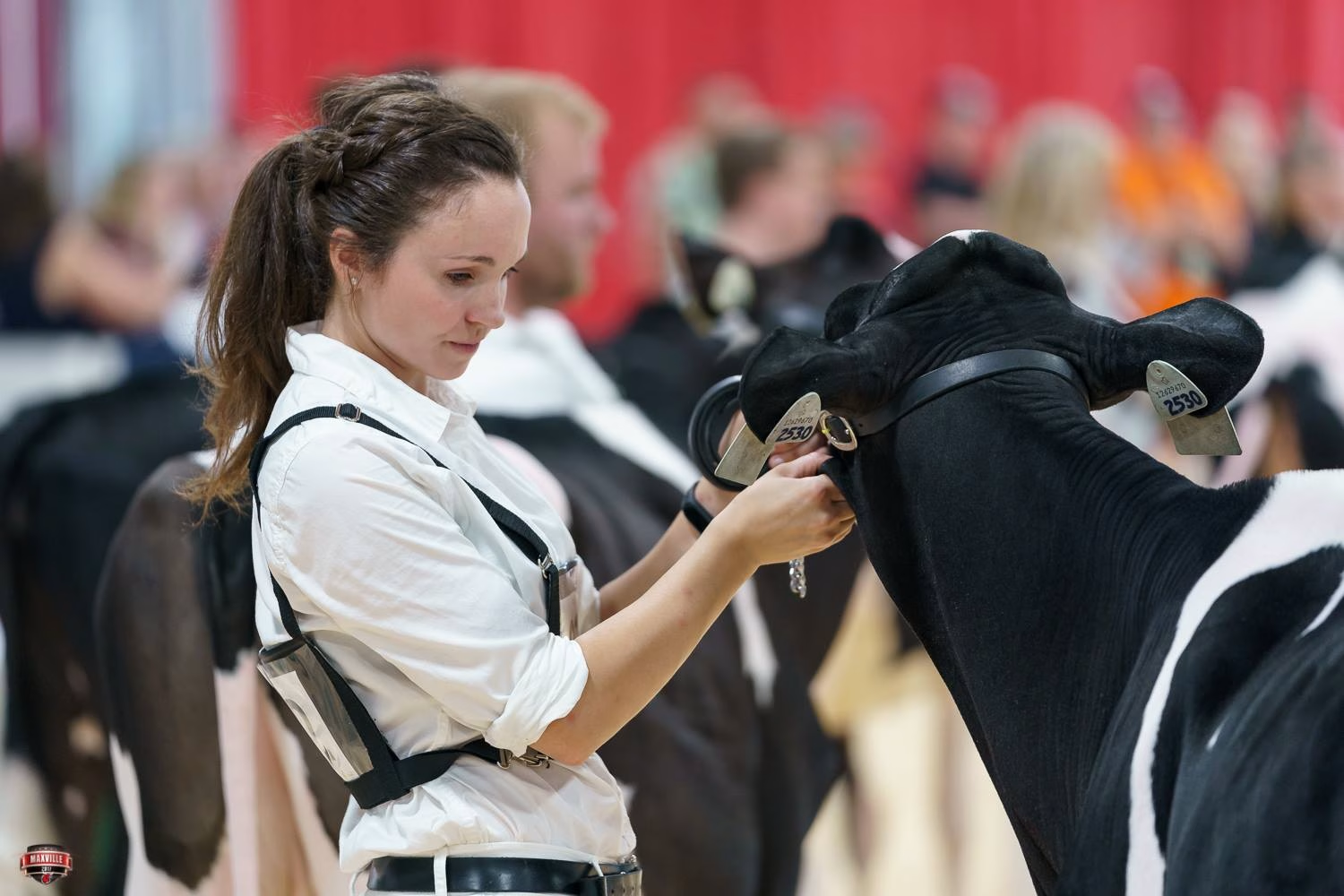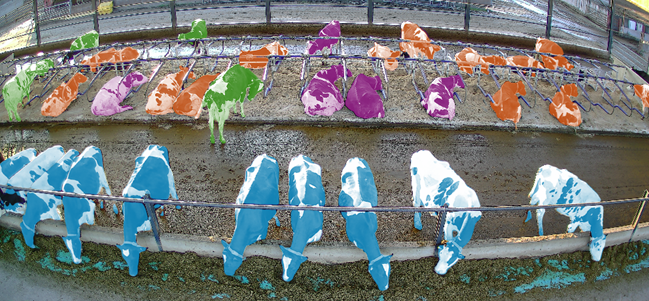Meet the newly appointed leaders of the American Jersey Cattle Association and National All-Jersey Inc. Who are the influential figures driving the future of USJersey?

The Board of Directors of the American Jersey Cattle Association for 2024-25 is pictured following the 156th Annual Meeting in Springfield, Mass., on June 22. Pictured, front row, from left: Rebecca Ferry, Johnstown, N.Y.; Neal Smith, Executive Secretary & CEO; President Alan Chittenden, Schodack Landing, N.Y.; Vice President Joel Albright, Willard, Ohio; second row: Donna Phillips, Newton, Wis.; Ralph Frerichs, LaGrange, Texas; Joe Vanderfeltz, Lawton, Pa.; Garry Hansen, Mulino, Ore.; John Maxwell, Donahue, Iowa; Ted DeMent, Kenney, Ill.; Tyler Boyd, Hilmar, Calif.; and Jason Johnson, Northwood, N.H. Not pictured: Cornell Kasbergen, Tulare, Calif., and Kevin Lutz, Lincolnton, N.C.
Heritage meets innovation at the annual meetings of the American Jersey Cattle Association (AJCA) and National All-Jersey Inc. (NAJ) on June 21 and 22, 2024, in Springfield, Mass. These crucial events go beyond routine; they elect new leaders and shape the Jersey cattle industry’s future. Gathered are top minds and dedicated individuals ready to share insights, celebrate achievements, and plan. Please stick with us for key takeaways and new leadership appointments shaping the upcoming year.
Alan Chittenden’s Third Term: A Testament to Legacy and Leadership in the Jersey Cattle Industry
Alan Chittenden was re-elected to his third one-year term as President of the American Jersey Cattle Association (AJCA) on June 24, 2024. As a fourth-generation breeder at Dutch Hollow Farms LLC in Schodack Landing, N.Y., Alan oversees a herd of 900 Registered Jerseys with his family. Their farm utilizes REAP services like registration and milk marketing support. Dutch Hollow Farms has been active in the Jersey Journal and has contributed to Equity for nearly 50 years.
The Chittenden family’s legacy is well-respected. 2012, they earned the AJCA Master Breeder award for their superior breeding practices. Alan has also held notable roles, such as General Chair of The All American Jersey Shows & Sales in 2018 and Chair of The All American Sales Committee in 2016. His experience includes six years as AJCA Director from the Second District (2014-2020).
Alan Chittenden’s reelection ensures continued stability and progress for the AJCA and the Jersey cattle industry, backed by his experience and proven leadership.
Outstanding Leadership and Dedication Among AJCA Directors The AJCA Directors, with their outstanding leadership and dedication, continue to demonstrate their commitment to the Jersey cattle industry. From Northwood, N.H., Jason Johnson was re-elected to his second three-year term as AJCA Director from the First District. Jason is a fourth-generation dairy farmer with a rich heritage in dairy farming and a degree in dairy management from the University of New Hampshire. He works as a farmer relationship manager with Stonyfield Organic, overseeing direct supply milk procurement, animal welfare, milk quality, and sustainability programs for the northeast milk supply.
Alongside his wife, Heather, and children, Regan, Ryleigh, and Asher, Jason breeds Johnsonacres Jerseys. He also serves as vice president of the New England Jersey Breeders Association. He contributes to the Development, Information Technology, and Identification committees while being part of the National Dairy Shrine board of directors.
Joe Vanderfeltz, of Lawton, Pa., was re-elected to his second term as Director from the Third District. He operates VanFel-JM Dairy with his wife, Melinda, and sons, Kyle and Corey, milking 220 Jersey and 180 Holstein cows.
The Vanderfeltz family manages around 700 acres of corn and alfalfa. Their herd is enrolled in REAP and boasts a 2023 herd average of 17,761 lbs. milk, 845 lbs. fat, and 680 lbs. protein on 153 lactations. Recognized for their excellence, they received the AJCA Young Breeder Award in 2003. Joe serves on the Breed Improvement and Finance committees and chairs the AJCA-NAJ Annual Meeting planning committee.
Kevin Lutz, from Lincolnton, N.C., was elected as AJCA Director from the Fifth District, succeeding retiring director Bradley Taylor. Lutz runs Treasure Chest Jerseys with his family, maintaining a 110-cow Registered Jersey herd enrolled on REAP, integrating registration, Equity milk marketing support, type appraisal, and performance programs.
His involvement with the AJCA includes serving on the Type Advisory Committee and past committee roles for The All-American Open Show and Sale. Kevin has judged The All American Jersey Show and the National Jersey Jug Futurity twice and officiated at national shows in Australia, Argentina, Ecuador, and Peru. He is also a North Carolina Jersey Cattle Association director and has held leadership roles with Southern States Cooperative and the Lincoln Soil and Water Conservation District.
Ralph Frerichs, of LaGrange, Texas, was re-elected to a second three-year term as AJCA Director from the Ninth District. A seasoned leader, Ralph served on the AJCA Board from 2009-2015, including roles as vice president and chair of the Development Committee. He currently serves on the Finance and Development committees.
Alongside his wife Faith, brother Robert, and son Neal, Ralph manages Frerichs Dairy Inc. This operation features 190 Registered Jersey cows and includes the Jersey Barnyard tourist attraction and the Texas Jersey Cheese Company, known for its all-natural, handmade Jersey cheese.
Meet the 2024-25 Committee Chairs: Pillars of Excellence from Coast to Coast The 2024-25 Committee Chairs, hailing from different parts of the nation, are acknowledged as pillars of excellence in the Jersey cattle industry. For the 2024-25 year, the chairs of the standing committees are dedicated professionals from across the nation:
- Cornell Kasbergen from Tulare, Calif., will lead the Finance Committee.
- Joel Albright from Willard, Ohio, has been appointed chair of the Breed Improvement Committee.
- Garry Hansen from Mulino, Ore., will head the Development Committee.
- Donna Phillips from Newton, Wis., will oversee the Information Technology and Identification Committee.
John Kokoski Re-Elected as NAJ President: A Legacy of Leadership and Dedication
John Kokoski was re-elected as president by the Board of Directors for National All-Jersey Inc. (NAJ) on June 21, 2024, underscoring his longstanding dedication and pivotal role in the organization. Kokoski, a member of the NAJ Board since 2007, operates Mapleline Farm LLC with his family, featuring a 135-cow Registered Jersey herd enrolled on REAP. They also run a dairy plant that processes and distributes Jersey milk products. Kokoski has served as a director of the Massachusetts Cooperative Milk Producers Federation and on the New England Dairy Promotion Board for over 25 years.
Jason Cast was elected Vice President of National All-Jersey Inc., succeeding James Huffard. Cast owns and operates JJC Jerseys with his wife and six children and has maintained a REAP-enrolled herd since 2013. His election signals a promising continuation of effective leadership within NAJ. Cast’s commitment to quality and sustainable dairy farming practices has significantly impacted the community.
Bradley Taylor Joins NAJ Board: A Seasoned Leader Enhances the Team
The NAJ Board welcomes Bradley Taylor as Director from District Five. From Booneville, Miss., Taylor operates Taylor Jersey Farm Inc. with his family. Their 120-cow Registered Jersey herd is part of REAP, highlighting their commitment to quality. Taylor has a rich history of leadership, having served as Finance Chair and on the Joint Operations Committee for the AJCA Board. His experience and dedication make him a solid asset to the NAJ Board.
The Bottom Line
The future of the USJersey organizations looks bright under the newly elected leadership. The Annual Meetings provided a perfect mix of continuity and fresh perspectives, vital for America’s evolving Jersey cattle industry. With Alan Chittenden’s reelection as AJCA President, his experienced leadership remains trusted. Leaders like Jason Johnson and Kevin Lutz exemplify dedication and expertise across different districts. The reappointments of Joe Vanderfeltz and Ralph Frerichs offer a solid foundation of wisdom and innovation. Additionally, John Kokoski and Jason Cast, in critical roles for National All-Jersey Inc., ensure steady guidance with strategies that benefit herders and the Jersey breed.
The takeaway is clear: these leaders will play pivotal roles ahead. Their collective experience and commitment are inspiring and essential for a prosperous future. Your active participation is crucial on this journey. Engage with your leaders, voice your concerns, and celebrate their achievements. Together, we can shape the future of the Jersey cattle industry.
Key Takeaways:
- Alan Chittenden was elected to his third one-year term as President of AJCA.
- Jason Johnson was re-elected to his second three-year term as AJCA Director from the First District.
- Joe Vanderfeltz was re-elected to his second term as Director from the Third District.
- Kevin Lutz was elected as AJCA Director from the Fifth District, succeeding Bradley Taylor.
- Ralph Frerichs was re-elected to a second three-year term as AJCA Director from the Ninth District.
- John Kokoski was re-elected as President of NAJ.
- Jason Cast was elected as Vice President of NAJ, succeeding James Huffard.
- Bradley Taylor was elected for a four-year term as Director from District Five to the NAJ board.
Summary:
The American Jersey Cattle Association (AJCA) and National All-Jersey Inc. (NAJ) held their annual meetings in Springfield, Mass., on June 21 and 22, 2024, to elect new leaders and shape the future of the Jersey cattle industry. Alan Chittenden, a fourth-generation breeder at Dutch Hollow Farms LLC, was re-elected to his third one-year term as President of the AJCA. The AJCA Directors, Jason Johnson, Joe Vanderfeltz, and Kevin Lutz, continue to demonstrate their commitment to the industry. Johnson oversees direct supply milk procurement, animal welfare, milk quality, and sustainability programs for the northeast milk supply. Vanderfeltz operates VanFel-JM Dairy with his wife, Melinda, and sons, Kyle, and Corey, and milks 220 Jersey and 180 Holstein cows. Lutz runs Treasure Chest Jerseys with his family and has served on the Type Advisory Committee and past committee roles for The All-American Open Show and Sale. Ralph Frerichs, a seasoned leader, has been re-elected as AJCA Director for a second three-year term. The 2024-25 Committee Chairs are dedicated professionals from across the nation, including Cornell Kasbergen from Tulare, Calif., Joel Albright from Willard, Ohio, Gary Hansen from Mulino, Ore., and Donna Phillips from Newton, Wis.













